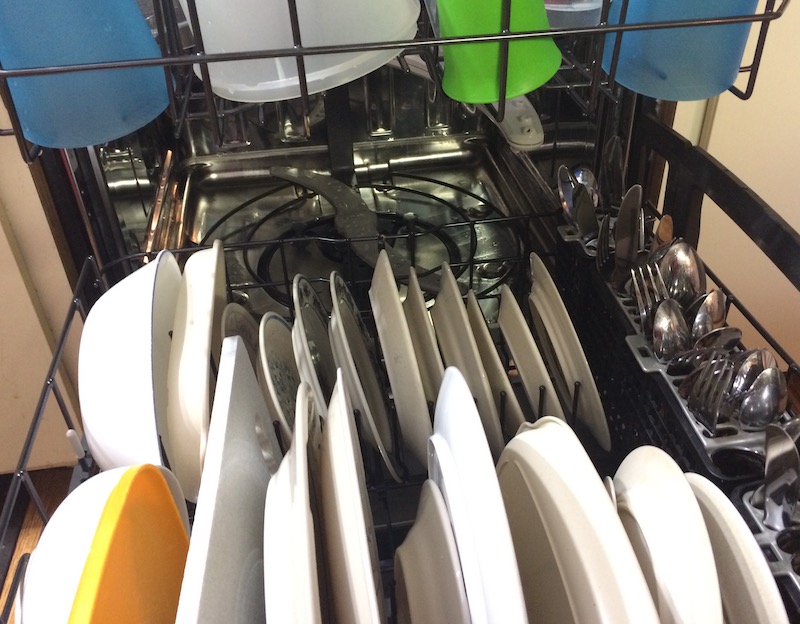How to Load a Dishwasher
How to load a dishwasher – a boring job that’s done most every day (well, more or less, depending upon the size of ones household). The process sounds simple enough, yet there are things to consider in the proper loading of a dishwasher that can make large differences in the outcome of the plates and silverware that are being put through the cleaning process. If using electricity (or gas), why not get the very best cleaning possible during the time that the machine is running?
Below are our tips on how to load to a dishwasher so that it can do its best possible job of cleaning.

How to Load a Dishwasher
Tips to Properly Load a Dishwasher
Silverware:
One of the biggest controversies is the question
of whether to load the silverware handle up or
handle down.
Most manufactures of dishwashers agree that the best
way to load the dishwasher silverware tray is to
leave the eating ends of the utensils pointing
upward. This allows the water and detergent easy
access to the most important part of the silverware,
the part that enters the mouth. The controversy that
arises with this arrangement is that someones
fingers will then be pressed all over the eating end
of the silverware after it has been cleaned. Good
argument, to which we respond the same as to many
other arguments – “wash your hands
first!”.
Don’t load sharp knives into the
dishwasher.
The exception to loading silverware would be sharp
knives, they should go point down to prevent
accidental cuts if you insist on taking this
shortcut to washing them by hand. But…
don’t put them in there in the first place!
Washing sharp knives in the dishwasher isn’t
good for the dishwasher or the knife. Sharp knives
will cut away at the plastic silverware bin and
either break it or expose the metal within which
will then rust. As far as the welfare of the sharp
knives, the water force dulls them as it pushes them
into other silverware and the basket. Also, some
handles will age and wear much more rapidly with
this abuse.
Other items that should skip the dishwasher are wooden utensils, wood cutting boards, cast iron pans, copper pots, copper mugs, hand painted dishes, vintage dishes, insulated travel mugs and disposable plastics.
Top Rack:
Bowls should be loaded on the top rack of the
dishwasher.
If they are loaded on the bottom of the dishwasher,
they can capture the water and prevent it from
reaching the glasses located on the top rack of the
dishwasher.
Glasses should be loaded on the top rack where
the pegs can keep them stable.
Glasses on the bottom rack can shake around during
the washing cycle and then break when they collide
with nearby plates.
Plastics should only be loaded into the top rack
of a dishwasher.
The bottom of a dishwasher gets hot enough to melt
many plastics which is not good for the object or
the dishwasher. Wedge plastic pieces between glass
pieces to keep them from flipping over when the
water starts up. Beware that some plastics will even
melt on the top shelf (they should be labeled
“hand wash only” or at least be missing
the “dishwasher safe” label on the
bottom.
Spacing:
Use the prongs.
All those
prongs were put there for purpose, be sure to use
them as intended.
Don’t overload a dishwasher.
Crowding won’t save anything as you’ll
just end up washing many of the items again because
they won’t get clean if water can’t run
freely all around and between them.
If you’ve loaded any tall items into the dishwasher, be sure to give the spray arms a turn to be sure that they won’t be blocked from spinning around when started.
Rinsing:
Should you rinse the dishes first?
Dishwashers are designed to rinse food residue from
plates, so they need some there to do their job. The
best solution is to keep a spatula near the
dishwasher and scrape plates before putting them
into the dishwasher. Then, just add the spatula to
the top rack of the washer when loading. The water
will break down any remaining food residue and if
not, then the food grinder will catch it.
The dirty water then passes through a filter, which should be cleaned from time to time (it’s part of a regular dishwasher maintenance program – see the owners manual). If this filter is not cleaned, the dishwasher will start to smell and food specks will remain on the dishes after a cycle making them feel rough.
How to Load a Dishwasher
Additional Info
Since each model of dishwasher is different, they all have specific loading instructions which can be found in the owners manual. If yours is missing, try downloading it from the manufacturer’s website.
Another item worth mentioning here is to watch for damage to the gasket (that long piece of black rubber that runs around the inside front perimeter of the dishwasher) that can possibly occur with un-careful loading of a dishwasher. If the gasket gets punctured, torn or otherwise damaged then the dishwasher will not seal properly and may leak. A new gasket can be ordered from the manufacturer if this ever happens and it’s pretty easy to slip a new one into place.
Before calling a repair man for your dishwasher, or other appliances, check out our posts on other simple fixes to large appliances and small kitchen appliances.










